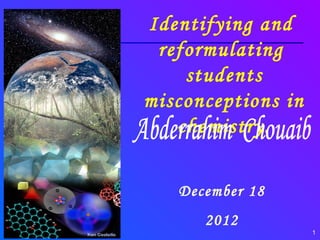
Misconception in chemistry ppt
- 1. Identifying and reformulating students misconceptions in chemistry. December 18 2012 1
- 2. Introduction- Relevant Research Chemistry is abstract by nature (Gabel 1999). It involves moving between multiple levels of representation, i.e. symbolic, microscopic and macroscopic ( Johnstone 2006) This leads to the development of Chemical misconceptions. The term misconception means any concept That differs from the commonly accepted scientific understanding of term. 2
- 3. For Example Water 1- Most 2- year-old children Can recognize and name the colorless, odorless liquid in glass because they know the properties of the phenomenon water. 2- another way to understand water is to represent it as collection of particles (molecules) with attractive forces between them 3
- 4. This representation is more Complex than focusing on physical properties of water. Third way is representing water by the symbol of hydrogen and oxygen to represent the formula 4
- 5. with Chemical misconception ? 1. Misconception interferes with learning new concepts derived from scientific theory 2. Learner’s misconception “affect what they Perceived to be happening in the classroom demonstration or laboratory experiments” 3. They are not changed or reduced by traditional forms of instruction. 5
- 6. Purpose The purpose of this study is to use CAT (Classroom Assessment Techniques) as methods of identifying students misconceptions in chemistry, and then to determine what types of treatments might be effective toward helping students redefine their concepts . 6
- 7. Classroom Assessment Technique has been enforced in Thailand as a result of Educational reform. The Science Education Department has reviewed their teaching and students’ assessment processes. The use of Classroom Assessment Technique improve students’ learning abilities and teachers’ teaching strategies in 10 grade chemistry 7
- 8. What is Classroom Assessment Techniques? Classroom Assessment Technique is formative assessment that can give you a precise idea of what your students like, what they are learning, what are their misconceptions about certain topic in chemistry, and what their attitudes are. By paying close attention to the climate in your classroom, you will be a more effective instructor.
- 10. Classroom Assessment Techniques (CATs) can help teachers learn what students know or don’t know or misunderstand. Learner-Centered Teacher-Directed Mutually Beneficial Formative Context-Specific Ongoing Rooted in Good Teaching Practice --Angelo, T. & Cross, P. (1993) Classroom Assessment Techniques. 2 nd Ed. San Francisco: Jossey-Bass.
- 11. Hypothesis of the study 1.How feasible is the CAT developed by the teacher for 10 grade chemistry class. 2. Can the CAT help improve a poorly performing student to achieve in chemistry class? 11
- 12. Best Practices of CAT’s •Decide what you want to learn from the assessments : Just like a scientific experiment, you need to have a purpose behind each assessment. For instance, you can ask your class, “What is the most important thing you learned today?” Give them one minute to write their response on a piece of paper. •Set goals : Have long-term goals for your class and administer assessments regularly to track progress. For instance, to encourage your class’s excitement about chemistry, you could create an attitude survey that you administer at regular intervals throughout the quarter or semester and use the feedback to adjust the curriculum. 12
- 13. Explain the purpose of the activity to students : Always explain to your students why you are administering a CAT and what you are trying to learn from it. This will help the students learn from the experience and provide a context for their answers. . 13
- 14. Keep assessments anonymous : If you really want honest feedback from your students, keep assessments anonymous. Do not grade assessments: CAT’s are meant to help instructors. Present your result to class. Well designed CAT will help students learn as well as the teacher. Focus on area where are they failing behind 14
- 15. 15
- 16. 16
- 17. I started using the Classroom Assessment Techniques in my chemistry class. Indeed I started reviewing my teaching strategies and my low performing students improve in the test and labs. Example of Classroom assessment Techniques in Regents chemistry next slide 17
- 18. Muddiest Point • What is the muddiest point or the most confusing part of the "balancing chemical equations ? • You have two minutes to respond and please use no more than one or two sentences. This is a way to assess how you are learning and not what you have learned. As we go through the semester there will be other types of assessment. This will allow you to focus more on your ability to learn and allow me to focus on the best methods to deliver the concepts. • Thanks • Your Chemistry teacher
- 19. Defining Features Matrix In the following Matrix please categorize each situation as (+)-Safe or (o)-Unsafe. Situation Safe Unsafe Walking into the lab (yesterday or today) 36% 64% without goggles to get your lab notebook Leaving your ice cream spoon on the table 18% 82% Pouring paper pulp down the sink 5% 95% Using a chemical without reading the label 100% Placing an unlabeled beaker on the counter 100% by the window Noting water on the floor and telling your lab 86% 14% partner Joking about drinking some of the 23% 77% chemicals that you are using Place your nose close to the chemicals you 100% are smelling Chewing gum in the lab area 18% 82%
- 20. Thank You 20